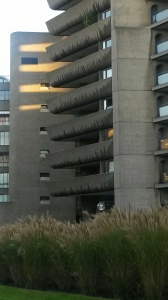
There are two Barbicans, we soon learn on a tour of the East London council estate: the multi-purpose arts centre; and the mysterious residential units which sell for seven figure sums.
Most visits to the former involve passing beneath the latter. But there is so much more to this brutalist landmark and unlikely home than the short journey from tube stop to gallery.
But if you feel the towers and apartments remain distant and inaccessible, this is no doubt part of the masterplan. Barbican, as etym fans will know, comes from old French and means outer fort.
In practice what this means is vertiginous high rises, playful arrow slit apertures on some of the streets in the sky, and endless vistas of concrete much of it with an hallmark distressed finish.
Our knowledgeable guide surrprises us by revealing that this extensive finish was achieved by hand, as a team of brave workers with pneumatic drills hung from the sides of the 42-storey building.
In a 90-minute circuit of the complex, there are plenty more revelations. The Barbican has plentiful green space, tennis courts and a five-a-side pitch. The water features proliferate.
So the famous concrete appears balanced by greenery and a sense of play. It is pointed out that a semi-circular motif ties fountains to benches to penthouse duplexes and all points in between.
This is just one of a few subtle details which make the whole site cohere. The eye takes them in, but they can fly under the radar, so it is a real joy to have them pointed out.
As you might have guessed, the approach to function and form is not entirely modernist. A tower built to house RSC stage sets above the stage of the theatre is disguised by a conservatory full of plants.
Meanwhile the tower blocks appear to rotate as you move around. The sharp triangular footprints turn their four bedroom apartments to face in different directions.
Upon their first appearance, not so long after WWII, they would have been dominant features of the London skyline. But from down here they still seem impossibly high and dynamic.
Other weird components to this island of unreality in the City include a medieval church, namely St Giles-without-Cripplegate and a police station which keeps office hours.
A tour lasts 90 minutes; it flies by; and it is recommended for anyone with rampant curiosity about the lifestyles of Britain’s best-heeled council tenants. If only they needed a blogger in residence.
There are daily tours of Barbican Estate between now and February 26. See the arts centre website for booking details.
No Comments